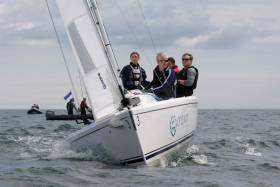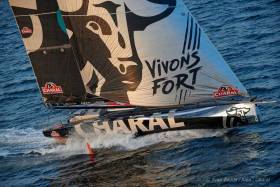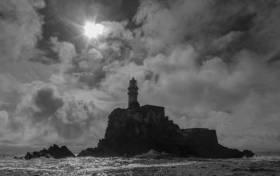Displaying items by tag: Fastnet Race
Howth Yacht Club’s Laura Dillon is among six women profiled by the Royal Ocean Racing Club ahead of their participation in this year’s Rolex Fastnet Race.
While crew lists for August’s race are not yet finalised, at present just over 10% of those competing in the biennial voyage will be women — more than double the rate of races in the 1990s.
The RORC cites role models such as Tracy Edwards, Ellen MacArthur and Dee Caffari as a reason for this increase in female participation — but notes that opportunities for women at all levels to go sailing are increasing “too slowly”.
For 40-year-old Laura Dillon, it was a high competitive drive from a young age that saw her progress from dinghies to 1720 Sportsboats to Beneteau Firsts in both the Round Ireland and Fastnet races.
This year she swaps the helm of Harry J Heijst’s S&S 41, Winsome, for a place on the four-strong crew of Conor Fogerty’s Figaro Beneteau 3, Raw — one of only three of the new offshore class in the race.
She observes that women’s participation in the Fastnet as enjoyed a considerable step up in the last generation — but says there is a direct parallel with women’s positions in the business world, and believes it will take another generation yet before their numbers increase substantially.
The Rolex Fastnet Race website has much more on this story HERE.
While the main kudos in the Rolex Fastnet Race comes from class wins or ultimately the Fastnet Challenge Cup for the overall IRC winner, who will simply be first home to Plymouth often turns into an engaging, heavyweight bout.
Among the monohull contenders this year, in one corner is the Hong Kong newcomer, Seng Huang Lee’s 100ft Scallywag, skippered by Australian David Witt with a crew featuring many of the sailors from their Volvo Ocean Race campaign.
In the other is George David’s familiar Juan K-designed Rambler 88, a boat that has been tweaked to within an inch of its life by its fastidious crew including many former Team New Zealand America’s Cup heroes.
For Scallywag, the Rolex Fastnet Race will be one of the pinnacles amid a major trophy-hunting season that kicks off in the Caribbean at Antigua Sailing Week and follows with the Antigua Bermuda Race, and then the historic Transatlantic Race 2019 from Newport, RI to Cowes via the Lizard. Post-Fastnet, Scallywag heads for the Med.
Part of Scallywag has enjoyed previous success in the Rolex Fastnet Race – her foredeck and some of her frames come from Charles St Clair Brown and Bill Buckley’s Maximus, line honours winner in 2005.
However, she was launched brand new for the 2014 Rolex Sydney Hobart as Ragamuffin 100 for Australian sailing legend Syd Fischer, who contributed to her design with Witt and naval architect Andy Dovell.
According to Witt, Scallywag — with a beam of 5.8m — falls between the slender multiple Hobart winner Wild Oats XI (5.1m beam) and the powerful Comanche (8m beam), the 2015 Rolex Fastnet Race line honours victor.
“We are the lightest 100 footer with the most sail area,” says Witt. The boat has a keel that cants to plus or minus 45 degrees, twin daggerboards and starts the season with a new boom.
Seng Huang Lee will be on board for the Rolex Fastnet Race. “His main goal with this boat is to win as many Rolex events as he can this year with the main emphasis being the Rolex Fastnet Race and the Rolex Sydney Hobart,” explains Witt, who personally has sailed the Fastnet many times including on the Grand Mistral/Maxi One Designs, Nicorette and on Knut Frostad’s VO70 Innovation Kvaerner.
Witt says he finds the Fastnet Race more challenging tactically than the annual race to Hobart: “It is around a rock, so it gives the chance to sail the boat in a different range of conditions. The Hobart race has been mostly straight downwind in recent editions.”
As to how they will get on against Rambler 88, the last time the two boats met in the 2015 Rolex Sydney Hobart, it was close: the longer Scallywag (then Ragamuffin 100) gained the upper hand at the finish line to win by just over four minutes.
“I’d hope we’re faster, but you never know,” says Witt. “We have only raced Rambler 88 once before and we got the better of them. But it’ll depend on far we have both come with our development.”
 George David’s Juan K-designed Rambler 88
George David’s Juan K-designed Rambler 88
One of the Rolex Fastnet Race’s most faithful combinations, George David and Rambler 88, returns for a fifth time in the hope of achieving a result they deserve finally.
As David states: “Too often we have been bridesmaid, which could be what brings us back along with the great traditions and scenery of this classic race.”
And this is despite David coming close to losing his life when in 2011 his Rambler 100 lost its keel and capsized after rounding the Fastnet Rock, leaving him in the water drifting away from the boat.
In that race David says they were on track to break the record, which ultimately went to the Ian Walker-skippered VO70, Abu Dhabi Ocean Racing, with a time of 1d 18h 39m 00s — the present monohull race record — while Mike Slade’s ICAP Leopard set the Maxi record of 1d 20h 09m 47s.
Recent races’ conditions haven’t favoured big boats on handicap. In 2003 Charles Dunstone came close to claiming ‘the double’ (ie line and handicap honours) with his Reichel Pugh 76 Nokia but was beaten across the line by Neville Crichton's Alfa Romeo 1. The last boat to score the double was Ludde Ingvall and his Maxi Nicorette in 1995.
Even rarer are the ‘triples’ — line and handicap honours plus the race record. Wild Oats XI managed it twice (2005 and 2012) in the Rolex Sydney Hobart and George David and Rambler have also enjoyed it in other races, notably the Rolex Middle Sea Race in 2007 (with a record that still stands), the 2016 Volvo Round Ireland Race and in last year’s RORC Caribbean 600.
“This has to be the goal for us in this year’s Rolex Fastnet although – as always – the weather needs to co-operate,” states David. “Big breeze should give us the edge against Scallywag and conversely lighter breeze won’t.”
This is the assessment too of Rambler 88’s eminent tactician Brad Butterworth: “Scallywag is a pretty fast boat – it has got a lot of sail area and a lot of stability. If it is a predominantly light to moderate air race it will be difficult to keep up with those guys, but if the breeze gets up and it gets sporty, we’ll have a chance. In 18 knots or more, we start to perform much the same as them.”
Rambler 88 goes into its fourth season highly refined, benefitting from several keel modifications and an ever-evolving sail wardrobe. “It has got better and better. Now it is going to its maximum,” states Butterworth. New for this season is a slightly lighter mast and a deeper keel.
And while this might seem to be a match race, a possible re-enactment of Rambler 88’s battle with Comanche in 2015, there are still other prospects. If conditions are brisk, how far behind them would a foiling IMOCA 60 like Jérémie Beyou’s Charal be?
For more details visit the Rolex Fastnet Race website HERE.
Giant IMOCA 60 Turnout for 2019 Fastnet Race
One of the largest fleets of IMOCA 60s ever gathered is due to set off on the Rolex Fastnet Race on Saturday, 3rd August. 29 of the boats, best known for their use in the Vendée Globe singlehanded non-stop round the world race, will assemble on the Cowes start line of the Royal Ocean Racing Club's premier event to take part in the biennial voyage to Plymouth via the Fastnet Rock - 26 competing in the IMOCA class, another three in the main IRC fleet.
This line-up is the third biggest in IMOCA history, after the 2016-17 and 2008-09 Vendée Globes, and is due to the Rolex Fastnet Race being a qualifier for the next Vendée Globe.
"However," adds Antoine Mermod, President of IMOCA, "the race means a lot and is important to French sailors because it is so historic. It also has a very nice course."
The IMOCA class is also now under the microscope internationally after its selection as one of the two classes for the next Ocean Race (ex-Volvo Ocean Race).
Newer IMOCA 60s incorporate the latest foiling technology. This has transformed their performance, reducing displacement and drag thanks to their foils partly, or at times fully, elevating them from the water. Since the last Vendée Globe in 2016-17 when this technology featured on a few top boats, second-generation foils are being fitted to the latest launches.
"At the best angle and boat speed the foils give a 15% jump in performance - it's huge," explains Mermod. "You sail at 13 knots and then when you start foiling the speed jumps to 18. You never do 15 knots!"
Eight new foilers are set to be on the start line of next year's Vendée Globe. Two are currently entered in the Rolex Fastnet Race - Jérémie Beyou's Charal, launched last year, and Sebastien Simon's Arkea-Paprec, a brand new design from Juan Kouyoumdjian, launching this June. Simon, the winner of last year's La Solitaire URGO Le Figaro, will be sailing with 2004-05 Vendée Globe winner Vincent Riou, who also won the Rolex Fastnet Race in 2015 aboard PRB. (PRB is also competing, but with new skipper Kevin Escoffier, who sailed Dongfeng Racing Team to victory in the last Volvo Ocean Race, alongside Jérémie Beyou).
Among the older foil-assisted boats are Bureau Vallée 2, formerly the 2016 Vendée Globe winner Banque Populaire, now skippered by Louis Burton. German skipper Boris Herrmann returns with Malizia (ex-Edmond de Rothschild), which he sailed to third place in the last Rolex Fastnet Race. Italian ex-Mini sailor Giancarlo Pedote has acquired the former St Michel Virbac previously campaigned by Jean-Pierre Dick and Yann Eliès.
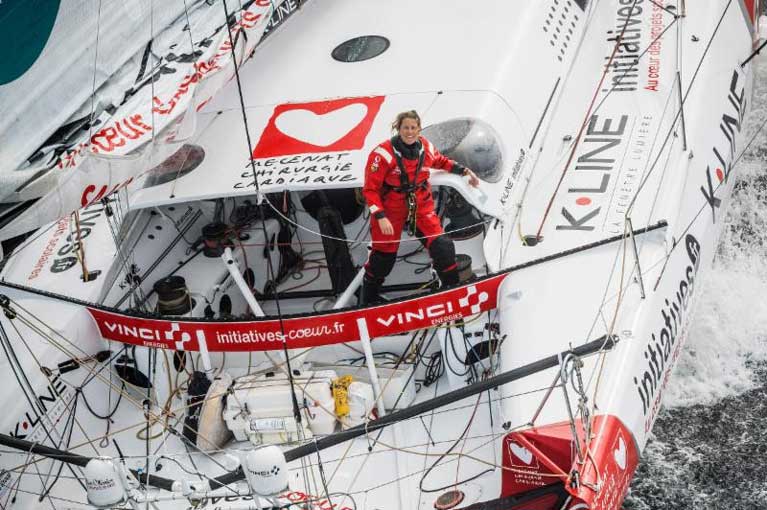 Sam Davies will compete with past winner Paul Meilhat on Initiatives Coeur © Vincent Curutchet / Initiatives Coeur
Sam Davies will compete with past winner Paul Meilhat on Initiatives Coeur © Vincent Curutchet / Initiatives Coeur
Britain's Sam Davies is back on Initiatives Coeur (originally Michel Desjoyeaux's 2008-9 Vendée Globe winner Foncia), having taken over this campaign from Tanguy de Lamotte, with whom she claimed fourth place in the last Rolex Fastnet Race. This time Davies is sailing with Paul Meilhat, winner of last year's Route du Rhum and the last Rolex Fastnet Race.
With the next Vendée Globe now 18 months away, many skippers have acquired boats that are new to them and are using this season to get acquainted.
Having sold their 2016-17 Vendée Globe winning IMOCA 60 to Louis Burton, Banque Populaire is back in the class having acquired the former MACIF/SMA, originally Francois Gabart's 2012-13 Vendée Globe winner. For their latest programme they have recruited 29-year-old Clarisse Crémer, following her second place in the 2017 Mini-Transat La Boulangère's Series class. On board for the Fastnet race with Crémer will be the team's principal skipper, 2016-17 Vendée Globe winner Armel le Cleac'h, as he awaits the launch of his new replacement Ultime maxi-trimaran.
One of the most impressive aspects of the Rolex Fastnet Race's mighty IMOCA line-up are the seven female skippers, three British. In addition to Sam Davies is former Mini sailor Pip Hare, who has acquired Superbigou, the boat on which Swiss skipper Bernard Stamm won the 2002-3 Around Alone and subsequent 2006-7 Velux 5 Oceans solo round the world races.
Miranda Merron makes a welcome return to the IMOCA 60 after a long tenure in the Class40 with her latest Campagne de France - the former Temenos/Great American IV. Of the Rolex Fastnet Race she says: "I have been around the Fastnet Rock countless times in the RORC's races or otherwise, but it is still the same mythical place with the amazing lighthouse. It is always a pleasure to round it." She is racing with her partner and IMOCA coach, French offshore sailing legend Halvard Mabire.
Other female skippers competing are Ireland's Joan Mulloy, on Mike Golding's former Gamesa, France's Alexia Barrier on 4myplanet and Franco-German skipper Isabelle Joschke on MACSF.
While it is not yet as internationally diverse as the Class40, still ten different countries are represented including two from Scandinavia: Norway's Oliver Korte on Galactic Viking (ex-Solidaire) in the IRC fleet and Finland's Ari Huusela on Ariel 2 (previously Dee Caffari's Aviva/GAES).
Eleven of the last Vendée Globe's 29 skippers (albeit only five finishers) will be racing in this year's Rolex Fastnet Race. Since that race several have graduated up: Swiss skipper Alan Roura (who sailed Pip Hare's boat to 12th place) now has Marc Guillemot's Safran while French skipper Fabrice Amedeo, who came home 11th, has acquired Pieter Heerema's No Way Back, a first generation foiler from the last race, rechristened Newrest - Art & Fenêtres.
As a genre IMOCA 60s date back to the early 1980s when it evolved in singlehanded oceanic races such as the BOC Challenge and OSTAR, however their development accelerated once they were adopted for the first Vendée Globe in 1989. A piece of IMOCA history is taking part in this year's Rolex Fastnet Race in the IRC fleet, with Jean-Marie Patier's Le Cigare Rouge, the narrow lightweight yawl that was runner-up in the second Vendée Globe in the hands of Jean-Luc van den Heede, winner of the recent Golden Globe Race.
Several boats are entered from the 2000 Vendée Globe, the race in which Dame Ellen MacArthur memorably fought Michel Desjoyeaux for the lead all the way up the Atlantic. Most notable of these is Alexia Barrier's 4myplanet, which in the hands of original owner Catherine Chabaud, won the Fastnet Challenge Cup outright under handicap 20 years ago.
For more information go to the Rolex Fastnet Race minisite here
Conor Fogerty's 'Raw' Among Fastnet Race's Most Complete Pantheon of Offshore Race Boats
The most impressive collection of offshore racing hardware from across the globe is set to gather off Cowes for the start of the Rolex Fastnet Race on 3 August writes James Boyd.
Following the 340 available places in the IRC fleet selling out in just four minutes and 37 seconds when entry opened on 7th January, the Royal Ocean Racing Club, organisers of this, the world's largest offshore yacht race, has provided a sneak preview of the 2019 line-up.
While the bulk of the fleet remains the IRC entries, competing for both their class titles as well as the overall Fastnet Challenge Cup, 2019 will see an unprecedented entry of 'non-IRC' boats, the majority from France. Entered at present are 25 Class40s (plus two more in the IRC fleet). There are also set to be a handful of Ultimes. At 100ft long, these maxi trimarans are the world's largest and fastest offshore race boats.
The present race record for the Rolex Fastnet Race was set in 2011 by the 130ft trimaran Banque Populaire V, skippered by Loïck Peyron, in a time of 32 hours 48 minutes at an average speed of 18.5 knots. While shorter, any of the new generation Ultimes is capable of bettering this time.
The Rolex Fastnet Race line-up includes an unusually large number of British female skippers taking part, among them Initiatives Coeur's Sam Davies and former Mini and Class40 sailor Pip Hare.
In sheer numbers the IRC fleet should once again be huge. At present the maximum entries has been comfortably exceeded although the exact number making it to the start will fluctuate due to circumstances, not least the requirement to comply with the RORC's race qualification requirements.
In the fight for monohull line honours, leading the charge should be the Hong Kong entry, Scallywag 100, skippered by David Witt (from the team that competed in the last Volvo Ocean Race). But she will face stiff competition from the highly refined Rambler 88 of American George David, the Fastnet Race's 2017 monohull line honours winner, and Ludde Ingvall's CQS.
Among the fleet are many past winners. This includes the reigning Rolex Fastnet Race champion, Didier Gaudoux, who returns with his faithful JND 39 Lann Ael 2. Conversely, returning with yet another new boat is 2015 winner and race veteran Géry Trentesaux, back this time on the bigger version of his victorious Courrier Du Leon, the JPK 11.80 Courrier Recommande. Given that French boats have won the last three editions of the Rolex Fastnet Race outright, it is no surprise that after the UK, French boats are second largest entry this year - with 58 in the IRC fleet, plus an additional 35 or so in the non-IRC classes.
At present class splits are a long way off being decided, but it is these classes themselves, and not the overall prize, that provide the most serious competition within the Rolex Fastnet Race. However already identifiable are groups of similar boats, due to have exceptional competition on the biennial 605 mile race from Cowes to Plymouth via the Fastnet Rock.
Before France's domination of the race, the race was twice won (in 2009 and 2011) by Niklas Zennström's Rán II. Mini Maxis and Maxi 72s are well represented again this year with Rán II back as Peter Harrison's Sorcha. She will be up against Bryon Ehrhart's Lucky (formerly the Rolex Maxi 72 World Champion Bella Mente) and Sir Peter Ogden's elongated former Maxi 72 Jethou.
Ex-Volvo Ocean Race boats are well represented in six VO70s, including David and Peter Askew's Wizard, winner of this year's RORC Caribbean 600 and Johannes Schwarz' Green Dragon and E1, while there are two VO65s including Team Brunel. Former Brunel Synergy skipper from the 1996-97 round the world race, Hans Bouscholte, is sailing Boudragon, previously Laurie Smith's Silk Cut - one of five VO60s taking part.
Perhaps the most intense battle in the IRC fleet will be between the seven Cookson 50s, including the fastest - American Ron O'Hanley's Privateer. One example, Ger O'Rourke's Chieftain, claimed the Rolex Fastnet Race outright in 2007. Also to be watched in this size range are the TP52s - Outsider, Tala and Rockall V plus Frenchman Eric de Turckheim's Nivelt-Muratet 54 Teasing Machine, winner of the 2017 RORC Transatlantic Race. The previous Teasing Machine, de Turckheim's Commodores' Cup-winning A13 is also competing now as Mark Emerson's Phosphorus II.
In the 40ft range there are five FAST40+ type boats - the Ker 40s, Keronimo and Ed Broadway's Hooligan, plus James Neville's HH42 Ino XXX, Ed Fishwick's GP42 Redshift and Stewart Whitehead's more contemporary Carkeek 40 Mk2, Rebellion.
The late Paul Heys would be proud of the giant J/Boats entry. These range from the J/133s, Yves Grosjean's Jivaro and Gilles Fournier and Corinne Migraine's Pintia, down to the four J/105s and the fifteen J/109s, spanning the RAF Sailing Association's Red Arrow (with an IRC TCC of 1.025), to Peter Rowe's Ju Kyu (on 1.003), via J/112s, J/120s and a large gaggle of J/122s.
Beneteau is also well represented with thirteen First 40s set to be on the start line and an additional eight First 40.7s. However, all eyes will be on the latest hardware from St Gilles Croix de Vie - the Figaro 3s, complete with their IMOCA 60-style foil packages. Three examples are entered including the Will Harris-skippered Hive Energy and from Ireland, Conor Fogerty's Raw.
Similarly, following their victories in the 2013 and 2015 races, there will be a strong JPK turn-out, including nine 10.10s (similar to the Pascal and Alexis Loisin's 2013 victor Night & Day) and five 10.80s (like Trentesaux's Courrier Du Leon).
The smallest boat race in this year's event will be between the trio of Contessa 32s, including Assent, campaigned by Simon Rogers of the Lymington-based Rogers clan that spawned the classic range.
A more complete pantheon of offshore race boats, you would be hard pressed to find anywhere, ever.
Entries for 340 Fastnet Race Places Snapped Up in Under Five Minutes
Once again the Rolex Fastnet Race has confirmed itself to be by far the world's largest offshore yacht race. After the entry for the Royal Ocean Racing Club's flagship event was opened at 1200 UTC, the 340 available places for boats in the IRC fleet were all taken within just four minutes and 37 seconds. This was just 13 seconds outside the record time recorded in 2017.
The first entry to sign up on the RORC's Sailgate online entry system for the biennial 605-mile race from Cowes to Plymouth via the Fastnet Rock off southwest Ireland, was regular competitor Derek Saunders and his Farr 60 Venomous. He narrowly beat the German Hamburgischer Verein Seefahrt club's Judel Vrolijk 52 Haspa Hamburg and Tom Kneen's JPK 11.80 Sunrise who were next fastest.
After the first two minutes, 180 boats had already been entered successfully. After the first frenetic four minutes and 37 seconds when the maximum entry limit was reached, subsequent requests were filtered through to the reserve list. Ultimately after the deluge subsided 440 boats had entered in total.
Yachts from 25 countries are due to take part this year: The bulk of these are from the UK, from where 201 boats were registered, followed by the dominant French (winners of the last three editions of the Rolex Fastnet Race) with 81 and the Netherlands with 33.
The entry includes a strong contingent of 16 boats from the USA, many making the passage across to the UK in the Transatlantic Race 2019. This leaves Newport, RI on 25 June bound for Cowes via the Lizard and is organised by the RORC in conjunction with the New York Yacht Club, Royal Yacht Squadron and Storm Trysail Club. Entries from further afield have been received from Australia, New Zealand, Russia, Turkey, Hong Kong and Korea among others.
This strong entry shows that the change of date has made little impression on the desire to do the Rolex Fastnet Race: The start date was moved to Saturday, 3 August and for the first time it will be setting off before Lendy Cowes Week (rather than on the traditional Sunday immediately after it).
For the RORC's Australian Racing Manager Chris Stone this is his first Rolex Fastnet entry day experience since taking up his position in Cowes a year ago: "It has been unbelievably busy. Before 1200 we had about 500 people who were all on stand-by, logged into their accounts, which was a good indicator about how busy it was going to be. Then we went straight to 340 and on to 440, including the waiting list."
Among the entries is at least one 100ft maxi while Stone reckons that one of the top fights in the race will potentially be between the six Cookson 50s.
It should be noted that with the Rolex Fastnet Race the RORC has led the way among the organisers of the world's classic 600 milers in inviting other grand prix racing yacht classes to compete outside of the main IRC fleet. This has led to the race featuring some of the very best offshore racing hardware from yachts competing in the Volvo Ocean Race to the giant 100ft long French Ultime multihulls and the IMOCA 60s of the Vendée Globe. For 2019, an especially strong line-up of Class 40s is anticipated. "We are expecting around another 50 boats - thirty Class 40s and twenty IMOCA boats," forecasts Stone.
Meanwhile, for the fleet, there remains the qualification process that will take place over the course of the 2019 season, with teams required to gain adequate miles and experience in order to meet the Rolex Fastnet Race's stringent entry requirements. Competing yachts must complete more than 300 race miles with at least 50% of their Rolex Fastnet Race crew on board.
"I never thought it would so easy to have 400 boats appear on your desk in one day! I am really impressed by the numbers. I have never experienced anything like this," concludes Stone.
Organisers Confirm Plymouth To Host 2019 Rolex Fastnet Race
Plymouth City Council and the Royal Ocean Racing Club (RORC) have confirmed that Plymouth will host the finish of the 2019 Rolex Fastnet Race.
Plymouth has marked the end of the renowned biennial offshore yacht race since its inception in 1925, and was the subject of speculation earlier this year that it could lose out on its traditional race-hosting duties to a coastal port in France.
As regular readers will recall, Afloat.ie was one of the earliest sources of the possible Fastnet Race change of format here
Starting in Cowes on the Isle of Wight, competitors in the Fastnet Race cover a course of 608 nautical miles and round the Fastnet Rock off the southwest coast of Ireland before returning via the Isles of Scilly to finish in Plymouth.
The race has a huge worldwide following and has seen continued growth over recent years, with the limit of 300 boats having to be increased to over 340 due to high demand.
Deputy leader of the council, Pete Smith said: “I’m delighted that the Rolex Fastnet is returning to its historic home once again in 2019.
“We are working closely with the organisers of the Rolex Fastnet Race, the Royal Ocean Racing Club, to enhance the experience of the thousands of sailors who arrive in Plymouth after competing in the race.”
Yachts come from all over the world to compete in the race which will start in Cowes on Saturday 3 August. The first yachts are expected to arrive in Plymouth in the early hours of Monday 5 August.
The Plymouth race village will be located at Yacht Haven at Mount Batten and will be open to the public from Tuesday 6 to Thursday 8 August, with live music, family-friendly activities and opportunities for local people to try their hand at on-water activities like sailing, kayaking and stand-up paddle boarding.
Cllr Smith continued: “The race is hugely significant for the city, helping to put Plymouth on the map and attracting visitors to see the finish of one of the world's most famous yacht races.
“We want to make sailing more accessible for people living here and encourage more participation in the sport. Hosting internationally renowned events like this is important to help motivate and inspire participation.”
RORC racing manager Chris Stone said: “Plymouth’s waterfront position is one of the most dramatic and beautiful in the UK and the city has amazing facilities for yachts and sailors. We are pleased to be working closely with Plymouth City Council to make the race bigger and better and provide a warm welcome for the 350-plus boats descending on the city.
“It is also a great opportunity for local people to come and experience our sport and understand how much fun it is and easily available to all.”
The Rolex Fastnet will be followed by the Britain’s Ocean City Blues n Jazz Festival from Friday 9 to Sunday 11 August, rounding off a week of celebration.
Fastnet Race Organisers Respond To Rumours That Finish Could Move To France
#FastnetRace - Organisers of the Rolex Fastnet Race have moved to shoot down rumours that the offshore classic was planning a move from its “ancestral home” in Plymouth to France, as the Plymouth Herald reports.
Earlier this month the Royal Ocean Racing Club (RORC) announced a shakeup for next year’s Fastnet with the news that it would start two weeks earlier than originally scheduled, in order to avoid poor weather implications and clashes with the UK bank holiday.
But race organisers have said these changes won’t involve a move away from its traditional Plymouth finish in 2019, despite the idea being mooted some years ago.
Spokesperson Trish Jenkins said RORC executives “are working with [Plymouth’s] city council on the 2019 race to make it bigger and better”.
The Plymouth Herald has more on the story HERE.
This article was updated on Friday 28 September to clarify statements from the RORC in the Plymouth Herald's report
Is This The Beginning Of The End Of The Fastnet Race As We Know It?
It was announced this week that the 2019 RORC Rolex Fastnet Race from Cowes will have a change of its original date, with its start moved back from Sunday, August 18th all the way to Saturday, August 3rd. W M Nixon wonders if this is the indication of bigger changes in the longterm pipeline.
It was a matter-of-fact announcement early last Monday, hidden away among the usual start-of-week newsflow items reporting the weekend’s sailing events. As far as can be discerned, it had been issued relatively unheralded as recently as 06.44 hrs on Monday morning. A trifle odd, surely, for a significant re-jigging in the calendar for a major international biennial event which is now less than 11 months away?
For the reality is that although the Fastnet Race is no longer such a big deal of endurance by comparison with the mega-events like the Volvo and Transoceanic races, for many of us it’s a very big part of our personal sailing life, and it is in turn imbued with its own almost mythic lore which continues to act as a magnet for offshore sailors worldwide, superstars and club sailors alike.
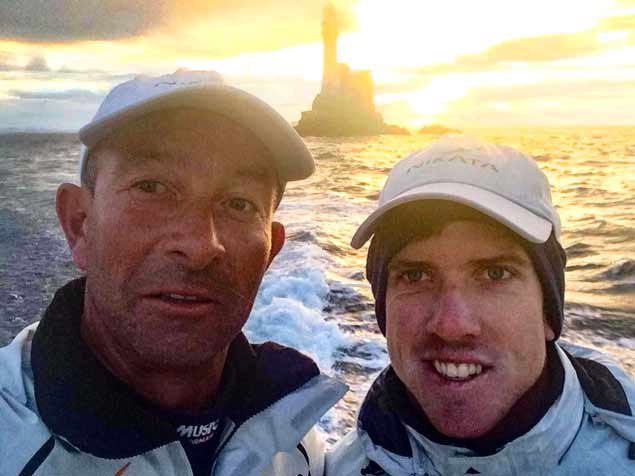 The Fastnet’s universal and eternal attraction is captured in this dawn photo at the rock of New Zealand’s Peter Burling (left) America’s Cup winner in 2017 and Olympic Gold Medallist (49er 2016) with shipmate Ian Budgen aboard the 115ft Nikata in the Rolex Fastnet Race 2017. Photo: Ian Budgen
The Fastnet’s universal and eternal attraction is captured in this dawn photo at the rock of New Zealand’s Peter Burling (left) America’s Cup winner in 2017 and Olympic Gold Medallist (49er 2016) with shipmate Ian Budgen aboard the 115ft Nikata in the Rolex Fastnet Race 2017. Photo: Ian Budgen
So any relatively late adjustment to the Rolex Fastnet Race we now know and hold sacred is viewed with a certain suspicion, even if the change – superficially at least – seems to be no more than a 15-day change of date, which is in part dictated by tides. But in fairness, we should post the Royal Ocean Racing Club release in full, and then maybe deconstruct its true meaning with all the paranoid weaponry available to us:
“Rolex Fastnet Race 2019 – Change of Date
The 2019 edition of the Rolex Fastnet Race will start on Saturday 3rd August 2019, which is two weeks earlier than the original published date.
Unusually, the race will now run the week before Lendy Cowes Week, whose dates remain unchanged, starting on Saturday 10th August. This break with tradition, in consultation with Lendy Cowes Week, has been made for a number of reasons, including weather concerns over late August.
"We have been wrestling with this decision over the summer and particularly the relative timing with other events in Cowes and the Solent," said RORC Commodore Steven Anderson. "A late August start has weather implications for our big fleet and we anticipated running into the summer bank holiday would cause difficulty for many participants. Bringing the race forward by two weeks addresses these issues and allows us to encourage the fleet into Cowes in the pre-race days before the start.”
Commenting on the change of date RORC Racing Manager Chris Stone said:
“Bringing the race forward to Saturday 3rd August will give more time for those competitors who wish to race in Lendy Cowes Week. The prize giving in Plymouth will now be held on Thursday 8th August and this will allow competitors to make the journey back to the Solent in time to join the racing.”
More detailed information and the official Notice of Race will become available very soon on the Rolex Fastnet Race website: www.rolexfastnetrace.com”
And that’s it. No matter which way it’s read, this amounts to a major change in the structure of August’s international sailing scene. “So what?” ask most sailors. Well, for those who have done, or are thinking of doing the Rolex Fastnet Race, part of its extraordinary attraction is its history and hallowed traditions. For sure, it can be a frustrating race which has you tearing your hair out. But its mythos is such that when the Entry List is officially opened online, it is filled within minutes despite running into 350-plus boats.
 One of the boats which may be affected by the Fastnet Race change of date is the American 1969 McCurdy-designed 48ft Carina, seen here rounding the rock in 2011’s race, when she won her class. Carina was planning to return in 2019 for the Golden Jubilee of her first participation in the Fastnet, and a 15-day change in the start date will be of significance for her plans. Photo Rolex
One of the boats which may be affected by the Fastnet Race change of date is the American 1969 McCurdy-designed 48ft Carina, seen here rounding the rock in 2011’s race, when she won her class. Carina was planning to return in 2019 for the Golden Jubilee of her first participation in the Fastnet, and a 15-day change in the start date will be of significance for her plans. Photo Rolex
In fact, the Rolex Fastnet Race is so popular that, with its traditional starting time at the end of Cowes Week, the fact that Cowes is already well filled with boats racing in the Week itself means there aren’t berths available for the huge numbers shaping up to do the Fastnet, and on the start morning most of them emerge from other havens all around the Solent.
So the desire to be in Cowes for a day or two before the start is certainly acknowledged and dealt with in the new proposal. But because so many crews only join their boats a day or two before the start, and they know that it is much easier to do so on the mainland than by getting yourself across to the Isle of Wight, the attraction of this Cowes-based option is not all that it seems.
And it also carries the risk of crews being led socially astray the night before the big race. The absolutely last thing you need when starting a Fastnet Race is a hangover and a rebellious digestive tract. There’s plenty of time to party after the race is over. And if that isn’t available, you’ve the whole winter to celebrate your own personal Fastnet achievement. But on the night before the start, be sensible. And the easiest way to do that is stay out of Cowes altogether.
But beyond that, what repeatedly comes up on the message board from Fastnet veterans is straightforward: the Fastnet Race from Cowes has simply never ever started before Cowes Week. For although in the Fastnet’s early days they were very much separate events, once they became part of a shared overall programme it all seemed to be as Nature intended.
From being an innovative upstart race in 1925 which had to be started at Ryde and sent off with its seven competitors eastward out of the Solent because none of the big Cowes clubs would touch such a foolhardy venture, the Fastnet Race gradually became a “must-do” event which fitted on neatly at the end of Cowes Week and sent the growing fleet westward through the Needles Channel, an extraordinary sight with the sluicing ebb.
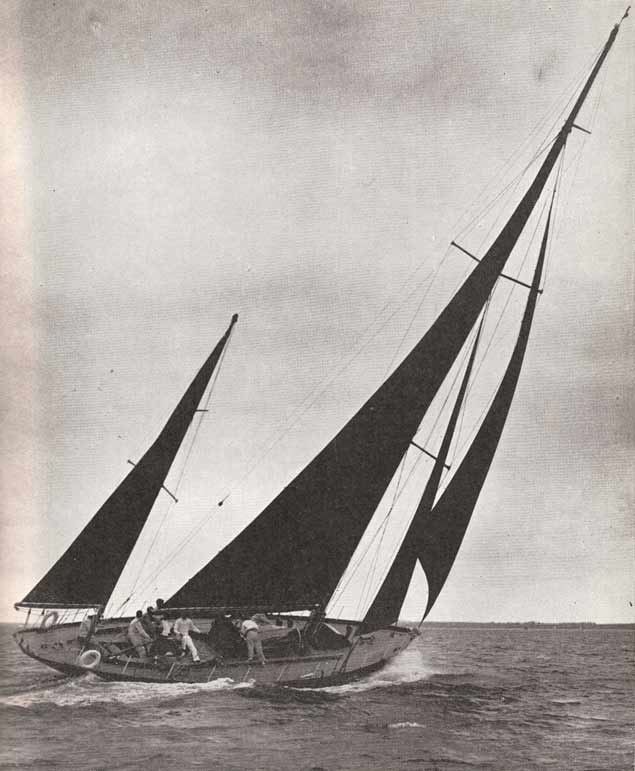 The Charles E Nicholson-designed Bloodhound, overall winner of the 1939 Fastnet Race. By this time, the Fastnet Race – first sailed in 1925 - had become a major event in the annual sailing calendar, and started from Cowes at the end of Cowes Week.
The Charles E Nicholson-designed Bloodhound, overall winner of the 1939 Fastnet Race. By this time, the Fastnet Race – first sailed in 1925 - had become a major event in the annual sailing calendar, and started from Cowes at the end of Cowes Week.
There has always been some level of Irish involvement in it from the very start, as Harry Donegan’s 17-ton cutter Gull from Cork was one of the pioneering seven in 1925, and finished third overall. And as the annual programme evolved over the years, the Fastnet’s established timing worked very well for Irish boats, as it enabled you to fit in some racing in Cowes Week, do the 603-mile Fastnet Race with its finish in Plymouth, and thus be left nicely placed to be back in Ireland before the late August gales became an increasing likelihood.
There even was a period – the Golden Years we might call them – when the boats involved really did live up to Uffa Fox’s dictum that “The best offshore racers make the best cruisers”. For in those halcyon days, offshore racers were very comfortably appointed down below, though you did try to keep weight out of the ends - but then that’s a good rule for any sailing boat including total cruisers.
Thus when an offshore race was over, you had this performance cruiser that could comfortably take you home on a proper little cruise to round out the season, and as a result there evolved the magic RORC-oriented high summer of sailing.
In this Summer of Dreams, you began sailing towards the peak of your programme with the RORC Channel Race, which started from Gosport on the Friday before Cowes Week, and put in a couple of hundred miles in a triangular course in the English Channel with the southerly turn off Cherbourg and the finish back at Gosport. Then you tootled across to Cowes where the Week was getting underway with morning service in the Parish church – “How nice to see all the old Cowes faces” as the Vicar used to start his sermon – and if you’d a Class I boat, during the Week the Britannia Cup on the Tuesday and the New York YC Cup in the Thursday were almost obligatory, after which you got ready for the Fastnet, and off you went on Saturday.
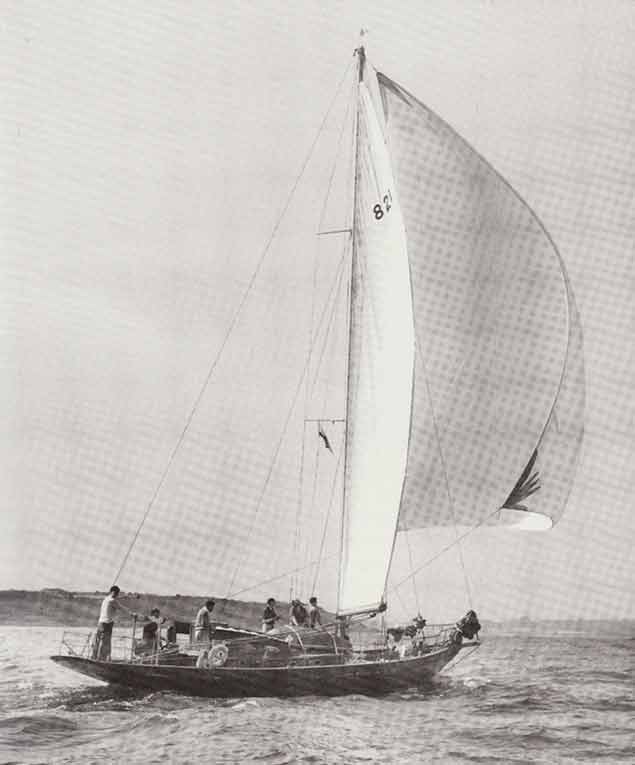 Frank & Eric Hopkirk’s 1894-built Glance (RUYC) at the start of the 1953 Fastnet Race, in which she won the Jolie Brise Cup
Frank & Eric Hopkirk’s 1894-built Glance (RUYC) at the start of the 1953 Fastnet Race, in which she won the Jolie Brise Cup
The hope was to be in Plymouth in time for the prize-giving in the Guildhall on the following Friday night, following which most Irish boats headed for home. But in the most enthusiastic years of the Corinthian era, there was even a post-Fastnet option, a RORC race from Plymouth to South Brittany or even La Rochelle to allow the possibility of some French coastal cruising before the summer was out.
By this time most folk had long since used up all their holiday time and in some cases all their money too. But a few determined hedonists, those with private means or barristers with their ludicrously long summer vacations, or perhaps stockbrokers and investors who operated on the old mantra of “Sell in May and Go Away, Come Back on St Leger Day”, they would be game for it, and in at least one year that included Frank and Eric Hopkirk from Belfast with their venerable cutter Glance and a crew of lawyers on leave.
It made for a long summer. Glance finally reappeared back in Ireland at Dunmore East sometime in September, and was left there “for collection by us next weekend”. But it took at least three weekends before the Glance crew eventually broke away from Dunmore East’s glue-pot embrace, and it was pushing November by the time she was finally hauled for the winter back at Bertie Slater’s boatyard on the shores of Ballyholme Bay.
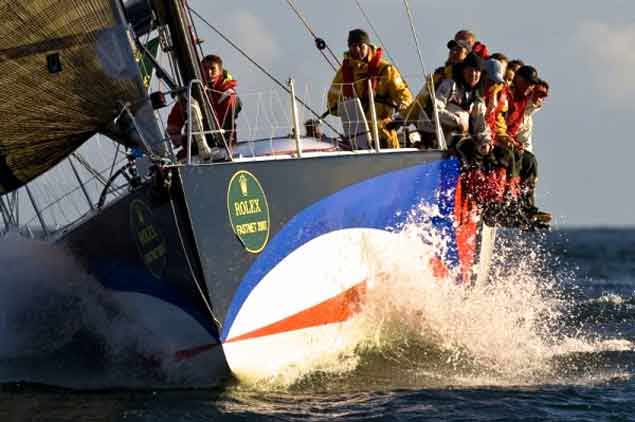 Ireland finally gets an overall Rolex Fastnet Race winner. Ger O’Rourke of Limerick’s Cookson 50 Chieftain at the finish line in Plymouth to take the supreme prize in 2007. One of Skipper O’Rourke’s first tasks ashore was to get himself a new shirt for the prize-giving. Photo: Rolex
Ireland finally gets an overall Rolex Fastnet Race winner. Ger O’Rourke of Limerick’s Cookson 50 Chieftain at the finish line in Plymouth to take the supreme prize in 2007. One of Skipper O’Rourke’s first tasks ashore was to get himself a new shirt for the prize-giving. Photo: Rolex
So when your own offshore racing years began in a place and an era when the legends of Glance and her crew still set the tone, the very idea that a valid Fastnet Race could be staged before Cowes Week would have seemed very peculiar indeed. And it still does. But the fact that it has to be contemplated shows how busy the international programme has become, and how much Cowes has moved on from being a little town which was the global focus of sailing for ten days early in August, into a place which is hiving with world class sailing for weeks on end.
And every second year, it has to cope with the unbelievable logistical challenge of choreographing a Rolex Fastnet Race start safely on its way. Visiting crews find this the most impressive thing of all until they get into the whitewater rush through the Needles Channel, and that can blow the mind. Then they add to the memory bank the rounding of the great headlands, until there’s the Fastnet Rock itself, the heart and soul and symbol of global offshore racing.
After that, the rush into Plymouth is sometimes not a rush at all, but it’s all part of the story, as is being in Plymouth itself. But the very idea that, after an inevitably hasty prize-giving on the night of Thursday 8th August 2019 in Plymouth, many crews will immediately wish to gather themselves and head for Cowes Week - that is just something that seems to fly right in the face of the natural order.
 The traditional 603-mile Rolex Fastnet Race course
The traditional 603-mile Rolex Fastnet Race course
But that is probably the curmudgeonly reaction of someone who found much pleasure in the old way of doing things. And maybe it will only be for this one year – maybe in 2021 the plan is to get back to the Fastnet Race following on immediately after Cowes Week in the traditional style.
But before that happens, we’ve to get through this year’s programme, and those who plan to go on to Cowes Week from Plymouth after the Fastnet Race will inevitably ask one simple question. Why not finish the Rolex Fastnet Race in Cowes while they’re at it? After all, the RORC - in addition to its splendid main clubhouse in London - has its fully-equipped support clubhouse in Cowes, and it would be a notable economy of effort and expense to finish the Fastnet Race where it started.
It’s not a new idea by any means, but it is bound to surface again next year of all years, and it will be like a red rag to a bull for all of those who think that sailing is much too Cowes-centred for its own good in any case.
Nevertheless, the logic of it is inescapable, even if it would mean the end of the Fastnet Race as we have known it for decades. For sure, a Fastnet Race starting and finishing at Cowes would have most of the essential elements of the historic event. But for Irish crews in particular, it would never be quite the same again.
For many of us, the passage home from Plymouth was the essential final chapter, just long enough to re-adjust to the upcoming realities of ordinary life. And for those of us returning to Ireland’s East Coast, it was always something special when, after the long haul up from Land’s End, you began to get into the lee of the Wexford coast, with the hint of the scent of farmland in the air, and thistledown carrying out over the sea in the sunlit evening breeze, a reminder that summer was going fast.
 Could this become history? George David’s Rambler 88 finishes the Rolex Fastnet Race 2017 in traditional style at Plymouth. Photo Rolex
Could this become history? George David’s Rambler 88 finishes the Rolex Fastnet Race 2017 in traditional style at Plymouth. Photo Rolex
Fastnet Race 2019 Date Change
The 2019 edition of the Fastnet Race will start on Saturday 3rd August 2019, which is two weeks earlier than the original published date.
Unusually, the race will now run the week before Cowes Week, whose dates remain unchanged, starting on Saturday 10th August. This break with tradition, in consultation with Lendy Cowes Week, has been made for a number of reasons, including weather concerns over late August.
"We have been wrestling with this decision over the summer and particularly the relative timing with other events in Cowes and the Solent," said RORC Commodore Steven Anderson. "A late August start has weather implications for our big fleet and we anticipated running into the summer bank holiday would cause difficulty for many participants. Bringing the race forward by two weeks addresses these issues and allows us to encourage the fleet into Cowes in the pre-race days before the start.”
Commenting on the change of date RORC Racing Manager Chris Stone said:
“Bringing the race forward to Saturday 3rd August will give more time for those competitors who wish to race in Cowes Week. The prize giving in Plymouth will now be held on Thursday 8th August and this will allow competitors to make the journey back to the Solent in time to join the racing.”
More detailed information and the official Notice of Race will become available here
IRC Congress Looks to the Future
Another successful annual IRC Congress meeting was held in early October in the popular sailing venue and race destination of St Malo on the northern French coast. Forty delegates from as far afield as Japan and the USA came together to talk about the International Rating Certificate (IRC) racing around the world, technical development and ideas on encouraging participation in yacht racing generally.
In 2018, there is the exciting prospect of the IRC European Championship combined with the RORC’s Commodores’ Cup in Cowes in June, closely followed by the joint IRC and ORC Hague Offshore World Championship in the Netherlands in July. These events set the high standard for IRC racing in 2018, along with the major offshore classic races that continue to be scored using IRC.
However, the IRC Congress never loses sight of the core of the IRC fleet who are taking part in club racing around the world every week and much talk at Congress was how to further encourage this. Everyone agreed that exciting events drive participation. This is demonstrated by the record four minutes for the Rolex Fastnet Race entry to be fully subscribed and the large number of boats that entered the Offshore Worlds straight after registration opened. Clubs were encouraged to put on events that provide an escape from the stresses of modern life, with a variety of courses, and some longer races with interesting destinations.
The IRC Technical Committee has been working on technical developments including the rating of boats equipped with foils, and a longer term review on rating ‘code zero’ sails. IRC has always been fast to embrace new developments in yacht design, while as far as possible retaining the characteristic simplicity of the IRC Rule and avoiding too much complexity for the majority of owners.


























